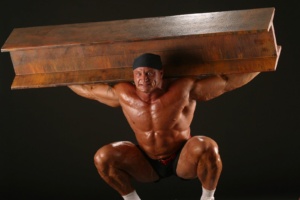 In part 1 I outlined three of the reasons why full body training is so effective, along with cool sample workouts. Now I’m going to show you how to design a total body program with two specific goals in mind: muscle growth or maximal strength gain. I don’t know any natural guy who thinks he’s too big and strong.
In part 1 I outlined three of the reasons why full body training is so effective, along with cool sample workouts. Now I’m going to show you how to design a total body program with two specific goals in mind: muscle growth or maximal strength gain. I don’t know any natural guy who thinks he’s too big and strong.
Before I get to that, let me quickly touch on one reason why there’s so much controversy surrounding the body part split vs. full body training debate.
You see, it’s common for people to look for training advice from the biggest guy in the room. That’s why every guy who’s looking to build muscle wants to know how Dorian Yates, Ronnie Coleman, or Jay Cutler trains. That’s exactly what I wanted to know back in my teens. And many bodybuilders with massive amounts of muscle follow some type of body part split. Yet, I’m telling you that a full body training program is the best way to build muscle.
Why the discrepancy?
 Training your entire body, each time you suit up for a workout, is the fastest way for 99% of lifters to gain muscle. I can’t make it any simpler than that. Full body training (aka total body training) is as popular as ever because that’s what the vast majority of lifters out there need.
Training your entire body, each time you suit up for a workout, is the fastest way for 99% of lifters to gain muscle. I can’t make it any simpler than that. Full body training (aka total body training) is as popular as ever because that’s what the vast majority of lifters out there need.
I’ve written countless articles and three books that revolve around full body training: Muscle Revolution, Huge in a Hurry, and Body of F.I.R.E. In fact, if you do a Google search for “full body training” or “total body training,” the T-nation article I wrote a few years back on the subject is the first to come up. (Out of 71.1 million possible results.)
It’s safe to say that my name is synonymous with the full body training philosophy, yet I still get frequent emails from avid lifters who want to try it but don’t know how to set up an effective plan.
So that’s why I decided to write this post. With the following information you’ll have all the tools you need to make full body training work for you.
First, let me explain why this type of training works so well. There are three reasons: exercise selection, hormonal response, and frequency.
Exercise Selection: when you train everything in one workout you must be wise with the exercises you choose. Of all the variables that make or break your muscle-gaining efforts, exercise selection is number one. Any body part split can be effective if it’s comprised of compound exercises. However, when you target specific muscle groups with body part split training you invariably do a bunch of isolation exercises that have little to no impact on adding muscle to your frame. With full body training, there’s no time to mess with concentration curls, kickbacks, and a host of other subpar exercises. By default, full body training steers you to compound exercises that give you the most bang for your buck.
I’ll bet you’re confused as ever when it comes to the simplest ways to build muscle. Many coaches and trainers have tried to convince you that you need to add a lot of fluff to your training program: tempo prescriptions,…
 My first training article was published almost 10 years ago. When I started writing my primary focus was telling people how to get bigger and stronger across their entire body. Articles such as Anti-Bodybuilding Hypertrophy, Total Body Training, and the Waterbury Method became huge hits on the internet with hundreds of thousands of hits. However, I swore I’d never write an arm training article. It probably wasn’t the smartest marketing strategy since 99.9% of guys want bigger arms, but I didn’t care. The subject just didn’t interest me.
My first training article was published almost 10 years ago. When I started writing my primary focus was telling people how to get bigger and stronger across their entire body. Articles such as Anti-Bodybuilding Hypertrophy, Total Body Training, and the Waterbury Method became huge hits on the internet with hundreds of thousands of hits. However, I swore I’d never write an arm training article. It probably wasn’t the smartest marketing strategy since 99.9% of guys want bigger arms, but I didn’t care. The subject just didn’t interest me.
Don’t get me wrong: in my late teens and early 20s I wanted bigger guns as much as the next guy. And probably just like you I thought the latest newsstand muscle magazine was going to hold the key to a magical arm routine that would suddenly pack meat on my skinny arms (my upper arm girth measured a pathetic 13.5″ when I started training them). After years of frustration I came to a conclusion that I hold to this day: Curls are curls. Sure, some variations are slightly better than others, but in the end they’re all basically the same. In other words, if you’ve been doing curls there’s not a variation in this universe that will suddenly make them grow.
Yet, I was able to naturally increase my upper arm girth to almost 20 inches once I figured out how to put the puzzle pieces together. Now, before you think this article is going to be a slam against arm curls and direct arm training in general, it’s not. To this day I do some type of direct arm work because it does help. However, it has its limitations and I never would’ve built big arms if I just kept doing curls and triceps extensions.

Eric Cressey is one of the few people I keep in my circle of advisors. He’s been training, studying, lifting and writing with passion and enthusiasm that’s rare in this field. Cressey Performance is definitely a place to check out if you’re in the Massachusetts area. So if you missed part I of my interview with him, be sure to check it out here.
Now we’ll pick up the rest of his interview where Eric discusses his awesome new training manual, Show and Go, for a bigger, stronger, healthier body.
CW: I got a good laugh reading your statement in the introduction of Show and Go. You said, “This book is for people who give a sh*t.” Care to elaborate?
EC: I was actually pretty excited to be able to swear whenever I wanted; I guess that’s the beauty of self-publishing! Rather than reinvent the wheel, I’ll share a little excerpt from the text that I think will answer the question:
““…you’ll find that the tone of this manual is much less conversational and entertaining, and much more “troubleshooting” and “do this and get diesel.” Fortunately, just as you’re more tolerant to cursing, you’re also more tolerant to training programs that will challenge, educate, and motivate you to all news levels of strength, performance, and health. My feeling is that you didn’t purchase this e-book to be entertained; you purchased it to get direction and results.

I first learned about Eric Cressey back in 2004 when he wrote a cool article on rotator cuff training for T-nation. Since that time Eric has quickly climbed to the top in the fitness industry. His knowledge of strength training and performance development is awesome (Cressey has a monstrous deadlift). But his techniques for corrective exercise – especially the shoulder – is what really sets him apart. In fact, when my brother recently injured his rotator cuff, Eric Cressey is the first person that came to mind to help him. Cressey Performance in Massachusetts has become one of the most sought-after training facilities in the country for everyone from professional athletes to weekend warriors.
When Cressey talks, I listen, because over the last 7 years he’s spent more time in the trenches than just about anyone I know. And that’s why I’m happy to have him as a guest this week.
So let’s get to it!
CW: First off, thanks for taking time out of your schedule to chat. Here’s my first question: Since you work with a lot of high-performance athletes, what are three principles that apply equally to athletes as well as non-athletes?
EC: I think people would be surprised to realize just how similar the Average Joe or Jane is to a professional athlete – both socially and physically.
The lay population often sits in front of a computer for 8-10 hours a day, but many pro athletes have 4-8 hour flights or 10+ hour bus rides where they’re sitting – and because they’re taller, sitting is even more uncomfortable and problematic. Like everyone else, they spend time surfing the internet, Skyping, playing video games, and goofing around on Facebook/Twitter. The advances in technology have hurt everyone from a physical fitness standpoint – but brought the “Pros and the Joes” closer together, believe it or not.
They’re also very similar in that they want the most bang for their buck. Most pro athletes are no different than anyone else in that they want to get in their training, and then go to visit their families, relax, play golf, or whatever else. They really don’t have interest in putting in six hours per day in training outside of the times when they have to do so (especially during the in-season).
With that in mind, three principles that are crucial to the success of both populations are:
1. Realize that consistency is everything. I always tell our clients from all walks of life that the best strength and conditioning programs are ones that are sustainable. It’s not about working hard for three months and making great progress – only to fall off the bandwagon for a month. This is absolutely huge for professional athletes who need to maximize progress in the off-season; they just can’t afford to have unplanned breaks in training if they want to improve from year to year.
If a program isn’t conducive to your goals and lifestyle, then it isn’t a good program. That’s why, when I created Show and Go I went out of my way to create 2x/week, 3x/week, and 4x/week strength training options – plus five supplemental conditioning options and a host of exercise modifications. I wanted it to be a very versatile resource.
Likewise, I wanted it to be safe; a program isn’t good if it injures you and prevents you from exercising. Solid programs include targeted efforts to reduce the likelihood of injury via means like mobility warm-ups, supplemental stretching recommendations, specific progressions, fluctuations in training stress, and alternative exercises (“plan B”) in case you aren’t quite ready to execute “Plan A.”
 This summer I decided to go on a vegetable juice fast. I’ve never done any type of fasting (unless you count the hours I’m sleeping) so I didn’t know what to expect. I always thought fasting was for emaciated hippies who weren’t tough enough to eat meat three times per day. But since my vegetable intake could use a healthy boost I gave it a trial run. You can read about my first 36 hours in part I here.
This summer I decided to go on a vegetable juice fast. I’ve never done any type of fasting (unless you count the hours I’m sleeping) so I didn’t know what to expect. I always thought fasting was for emaciated hippies who weren’t tough enough to eat meat three times per day. But since my vegetable intake could use a healthy boost I gave it a trial run. You can read about my first 36 hours in part I here.
So now I’ll pick up on the night of day 2 of my vegetable juice fast. (I didn’t give you all the details of day 2 in part I.)
The first day, as mentioned, was a little rough. I was as hungry as an angry boar by mid afternoon but I stayed busy enough to fight off the hunger pangs. On day 2, my hungry was more manageable. By evening I decided it was time to replenish my muscles. I was leaner by day 2, for sure, but I felt pretty weak. So at 7pm on day 2 I did a circuit of 10 kettlebell swings, 10 clap push-ups, and 5 pull-ups for 10 rounds. I was weaker than normal but my endurance was up to par, maybe even a little higher. This was a pleasant surprise.
 The first thing you need to know when you look at “Mad Scientist Muscle” is that it’s actually a serious program and a damn good program. Don’t let the name fool you. This program by Nick Nilsson is based on solid, scientific training principles and is definitely not just same random crazy crap that’s thrown together.
The first thing you need to know when you look at “Mad Scientist Muscle” is that it’s actually a serious program and a damn good program. Don’t let the name fool you. This program by Nick Nilsson is based on solid, scientific training principles and is definitely not just same random crazy crap that’s thrown together.
There is a method to his madness. I’m not saying there isn’t some really cool and effective stuff in there…it’s just not random…
Controlled Overtraining…
What Nick has done is put together a series of programs based on the concept of “controlled overtraining,” also known as “accumulation and intensification” or “dual factor theory.”
To put it simply, in these programs, you’ll gradually ramp up your training volume by increasing the number of sets you’re doing (this is done on a weekly basis), while simultaneously DECREASING your rest periods in between sets, thus increasing the overall density of your training in a very deliberate fashion.
This is the “accumulation” phase as you’re gradually accumulating workload and training volume over the course of 3 weeks.
So, when you HIT this point of overtraining, that’s when you back off on both the training volume AND the rest periods. You’ll do fewer sets and with long rest periods in between sets. You’re also going to reduce the rep ranges so that you’re working with more power and strength-oriented loads.
 Vegetables are the best food on earth. A magical food group, if there ever was one. It doesn’t matter if you want to burn more fat, build muscle, or improve your overall health, consuming more vegetables on a daily basis will make a dramatic difference. How many foods can you say that about?
Vegetables are the best food on earth. A magical food group, if there ever was one. It doesn’t matter if you want to burn more fat, build muscle, or improve your overall health, consuming more vegetables on a daily basis will make a dramatic difference. How many foods can you say that about?
To stay lean and healthy, I can sum up a lifelong nutritional strategy in one sentence: consume vegetables all day long with some lean protein. Veggies reduce inflammation, fight cancer and every disease, and they’re loaded with nutrients your body needs to keep your good hormones up and bad hormones down.
But there’s a problem: I despise eating vegetables. Sure, I wave a big ol’ veggie flag because my clients’ results depend on eating plenty of them, but in my own life I’ll freely admit that my intake is woefully inadequate. So I recently took it upon myself to change my ways.
